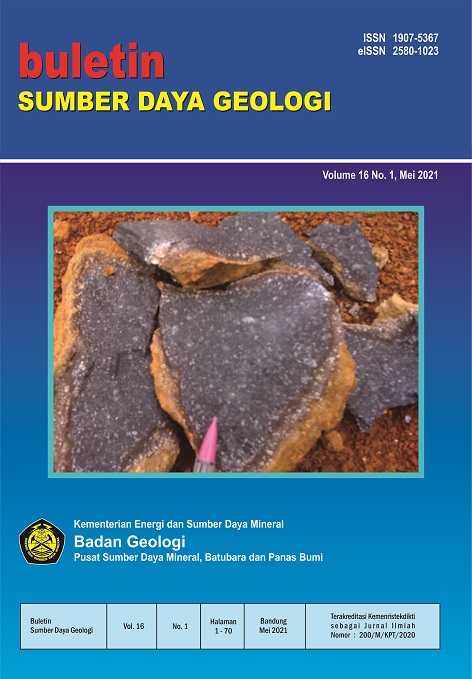TINJAUAN PUSTAKA KARAKTERISASI DAN POTENSI PEMANFAATAN FLY ASH DAN BOTTOM ASH (FABA)
REVIEW ON CHARACTERIZATION AND UTILIZATION POTENTIAL OF FLY ASH AND BOTTOM ASH (FABA)
Abstract
Fly ash and bottom ash (FABA) is defined as waste residu that is produced from coal combustion process in electric power plant. Its production will increase due to high demand of electric energy. It commonly consists of silica, alumina, ferric oxide, and others oxide. Coal ash is also an economically promising resource for extraction of several valuable elements, including Ge, Ga, rare earth elements and yttrium (REY), Nb, Zr, V, Re, Au, Ag, and base metals such as Al. Physical and chemical characteristics of FABA are important because it will affect their option of re-use and disposal method. Other potential utilization for FABA was involved geotechnical applications such as geopolymer material. Cenospheres are one of the most valuable materials found in FABA. To increase the potential use of FABA, many separation techniques have been developed to extract the value-added components, including: cenospheres, valuable metal and trace elements such as rare earth element and yttrium (REY), also the unburned carbon.
Downloads
References
Abbott, M.F. and Austin, L.G., 1985. Studies on slag deposit formation in pulverized-coal combustors: 6. sticking behaviour of slag drops from three Pennsylvania steam coals. Fuel, 64(6), pp.832-838.
Abdel-Gawwad, H.A. and Abo-El-Enein, S.A., 2016. A novel method to produce dry geopolymer cement powder. HBRC journal, 12(1), pp.13-24.
Acar, I. and Atalay, M.U., 2016. Recovery potentials of cenospheres from bituminous coal fly ashes. Fuel, 180, pp.97-105.
Adelizar, A.S., Olvianas, M., Adythia, D.M., Syafiyurrahman, M.F., Pratama, I.G.A.A.N., Astuti, W. and Petrus, H.T.B.M., 2020. Fly ..ash and bottom ash utilization as geopolymer: Correlation on compressive strength and degree of polymerization observed using FTIR. MS&E, 742(1), p.012042.
Ahmaruzzaman, M., 2010. A review on the utilization of fly ash. Progress in energy and combustion science, 36(3), pp.327-363.
Alonso, E., Sherman, A.M., Wallington, T.J., Everson, M.P., Field, F.R., Roth, R. and Kirchain, R.E., 2012. Evaluating rare earth element availability: A case with revolutionary demand from clean technologies. Environmental science & technology, 46(6), pp.3406-3414.
Balaram, V., 2019. Rare earth elements: A review of applications, occurrence, exploration, analysis, recycling, and environmental impact. Geoscience Frontiers, 10(4), pp.1285-1303.
Besari, D.A.A., 2018. Komponen Penyusun dan Model Keterdapatan Rare Earth Elements and Yttrium (REY) pada Fly Ash dan Bottom Ash (Bachelor thesis, Universitas Gadjah Mada).
Bhatt, A., Priyadarshini, S., Mohanakrishnan, A.A., Abri, A., Sattler, M. and Techapaphawit, S., 2019. Physical, chemical, and geotechnical properties of coal fly ash: a global review. Case Studies in Construction Materials, 11, p.e00263.
Blissett, R.S. and Rowson, N.A., 2012. A review of the multi-component utilisation of coal fly ash. Fuel, 97, pp.1-23.
Blissett, R.S., Smalley, N. and Rowson, N.A., 2014. An investigation into six coal fly ashes from the United Kingdom and Poland to evaluate rare earth element content. Fuel, 119, pp.236-239.
Cabielles, M., Rouzaud, J.N. and Garcia, A.B., 2009. High-resolution transmission electron microscopy studies of graphite materials prepared by high-temperature treatment of unburned carbon concentrates from combustion fly ashes. Energy & fuels, 23(2), pp.942-950.
Cameán, I. and Garcia, A.B., 2011. Graphite materials prepared by HTT of unburned carbon from coal combustion fly ashes: Performance as anodes in lithium-ion batteries. Journal of Power Sources, 196(10), pp.4816-4820.
Chiang, P.C. and Pan, S.Y., 2017. Fly Ash, Bottom Ash, and Dust. In Carbon Dioxide Mineralization and Utilization (pp. 253-264). Springer, Singapore.
Chindaprasirt, P., Chareerat, T., Hatanaka, S. and Cao, T., 2011. High-strength geopolymer using fine high-calcium fly ash. Journal of Materials in Civil Engineering, 23(3), pp.264-270.
Clarke, L.B., 1993. The fate of trace elements during coal combustion and gasification: an overview. Fuel, 72(6), pp.731-736.
Cokca, E. and Yilmaz, Z., 2004. Use of rubber and bentonite added fly ash as a liner material. Waste management, 24(2), pp.153-164.
Dai, S., Ren, D., Zhou, Y., Chou, C.L., Wang, X., Zhao, L. and Zhu, X., 2008. Mineralogy and geochemistry of a superhigh-organic-sulfur coal, Yanshan Coalfield, Yunnan, China: evidence for a volcanic ash component and influence by submarine exhalation. Chemical Geology, 255(1-2), pp.182-194.
Dai, S., Zhao, L., Hower, J.C., Johnston, M.N., Song, W., Wang, P. and Zhang, S., 2014. Petrology, mineralogy, and chemistry of size-fractioned fly ash from the Jungar power plant, Inner Mongolia, China, with emphasis on the distribution of rare earth elements. Energy & fuels, 28(2), pp.1502-1514.
Dai, S., Zhao, L., Peng, S., Chou, C.L., Wang, X., Zhang, Y., Li, D. and Sun, Y., 2010. Abundances and distribution of minerals and elements in high-alumina coal fly ash from the Jungar Power Plant, Inner Mongolia, China. International Journal of Coal Geology, 81(4), pp.320-332.
Danish, A. and Mosaberpanah, M.A., 2020. Formation mechanism and applications of cenospheres: a review. Journal of Materials Science, pp.1-19.
Direktorat Jenderal Mineral dan Batubara, 2021. Fly ash dan bottom ash (FABA) di Indonesia (press release). Jakarta : Direktorat Jenderal Mineral dan Batubara Kementerian Energi dan Sumberdaya Mineral.
Direktorat Jenderal Mineral dan Batubara, 2019. Laporan Kinerja Tahun 2019. Jakarta : Direktorat Jenderal Mineral dan Batubara Kementerian Energi dan Sumberdaya Mineral.https://esdm.go.id/assets/media/content/content-laporan-kinerja-ditjen-minerba2019.pdf
Du, X. and Graedel, T.E., 2013. Uncovering the end uses of the rare earth elements. Science of the Total Environment, 461, pp.781-784.
Eskenazy, G.M., 1987. Rare earth elements in a sampled coal from the Pirin deposit, Bulgaria. International Journal of Coal Geology, 7(3), pp.301-314.
Fomenko, E.V., Anshits, N.N., Solovyov, L.A., Mikhaylova, O.A. and Anshits, A.G., 2013. Composition and morphology of fly ash cenospheres produced from the combustion of Kuznetsk coal. Energy & fuels, 27(9), pp.5440-5448.
Franus, W., Wiatros-Motyka, M.M. and Wdowin, M., 2015. Coal fly ash as a resource for rare earth elements. Environmental Science and Pollution Research, 22(12), pp.9464-9474.
Goodarzi, F., 2006. Characteristics and composition of fly ash from Canadian coal-fired power plants. Fuel, 85(10-11), pp.1418-1427.
Gray, M.L., Champagne, K.J., Soong, Y., Killmeyer, R.P., Maroto-Valer, M.M., Andrésen, J.M., Ciocco, M.V. and Zandhuis, P.H., 2002. Physical cleaning of high carbon fly ash. Fuel processing technology, 76(1), pp.11-21.
Hoenderdaal, S., Espinoza, L.T., Marscheider-Weidemann, F. and Graus, W., 2013. Can a dysprosium shortage threaten green energy technologies?. Energy, 49, pp.344-355.
Hower, J.C., 2012. Petrographic examination of coal-combustion fly ash. International Journal of Coal Geology, 92, pp.90-97.
Hower, J.C., Henke, K.R., Dai, S., Ward, C.R., French, D., Liu, S. and Graham, U.M., 2017a. Generation and nature of coal fly ash and bottom ash. In Coal Combustion Products (CCP's) (pp. 21-65). Woodhead Publishing.
Hower, J.C., Groppo, J.G., Graham, U.M., Ward, C.R., Kostova, I.J., Maroto-Valer, M.M. and Dai, S., 2017b. Coal-derived unburned carbons in fly ash: A review. International Journal of Coal Geology, 179, pp.11-27.
Ketris, M.P. and Yudovich, Y.E., 2009. Estimations of Clarkes for Carbonaceous biolithes: World averages for trace element contents in black shales and coals. International Journal of Coal Geology, 78(2), pp.135-148.
Kolias, S., Kasselouri-Rigopoulou, V. and Karahalios, A., 2005. Stabilisation of clayey soils with high calcium fly ash and cement. Cement and Concrete Composites, 27(2), pp.301-313.
Komnitsas, K. and Zaharaki, D., 2007. Geopolymerisation: A review and prospects for the minerals industry. Minerals engineering, 20(14), pp.1261-1277.
Kutchko, B.G. and Kim, A.G., 2006. Fly ash characterization by SEM–EDS. Fuel, 85(17-18), pp.2537-2544.
Lin, R., Bank, T.L., Roth, E.A., Granite, E.J. and Soong, Y., 2017. Organic and inorganic associations of rare earth elements in central Appalachian coal. International Journal of Coal Geology, 179, pp.295-301.
Loya, M.I.M. and Rawani, A.M., 2014. A review: promising applications for utilization of fly ash. Int. J. Adv. Technol. Eng. Sci, 2, pp.143-149.
Massari, S. and Ruberti, M., 2013. Rare earth elements as critical raw materials: Focus on international markets and future strategies. Resources Policy, 38(1), pp.36-43.
Meawad, A.S., Bojinova, D.Y. and Pelovski, Y.G., 2010. An overview of metals recovery from thermal power plant solid wastes. Waste Management, 30(12), pp.2548-2559.
Meij, R., 1994. Trace element behavior in coal-fired power plants. Fuel processing technology, 39(1-3), pp.199-217.
Mraw, S.C., De Neufville, J.P., Freund, H., Baset, Z., Gorbaty, M.L. and Wright, F.J., 1983. The science of mineral matter in coal. In Coal science (pp. 1-63). Academic Press.
Mukherjee, A.B., Zevenhoven, R., Bhattacharya, P., Sajwan, K.S. and Kikuchi, R., 2008. Mercury flow via coal and coal utilization by-products: a global perspective. Resources, Conservation and Recycling, 52(4), pp.571-591.
Ngu, L.N., Wu, H. and Zhang, D.K., 2007. Characterization of ash cenospheres in fly ash from Australian power stations. Energy & Fuels, 21(6), pp.3437-3445.
Pandian, N.S., 2013. Fly ash characterization with reference to geotechnical applications. Journal of the Indian Institute of Science, 84(6), p.189.
Reddy, C.S., Mohanty, S. and Shai, R., 2018. Physical, chemical and geotechnical characterization of fly ash, bottom ash and municipal solid waste from Telangana State in India. International Journal of Geo-Engineering, 9(23).
Querol, X., Fernández-Turiel, J. and López-Soler, A., 1995. Trace elements in coal and their behaviour during combustion in a large power station. Fuel, 74(3), pp.331-343.
Ram, L.C. and Masto, R.E., 2014. Fly ash for soil amelioration: a review on the influence of ash blending with inorganic and organic amendments. Earth-Science Reviews, 128, pp.52-74.
Ranjbar, N. and Kuenzel, C., 2017. Cenospheres: A review. Fuel, 207, pp.1-12.
Rosita, W., Besari, D.A.A., Bendiyasa, I.M., Perdana, I., Anggara, F., and Petrus, H.T.B.M., 2020. Potency of rare earth elements and yttrium in Indonesian coal ash. Key Engineering Materials, 849, pp.102-107.
Sahoo, P.K., Kim, K., Powell, M.A. and Equeenuddin, S.M., 2016. Recovery of metals and other beneficial products from coal fly ash: A sustainable approach for fly ash management. International Journal of Coal Science & Technology, 3(3), pp.267-283.
Seredin, V.V. and Dai, S., 2012. Coal deposits as potential alternative sources for lanthanides and yttrium. International Journal of Coal Geology, 94, pp.67-93.
Seredin, V.V., Dai, S., Sun, Y. and Chekryzhov, I.Y., 2013. Coal deposits as promising sources of rare metals for alternative power and energy-efficient technologies. Applied Geochemistry, 31, pp.1-11.
Sokol, E.V., Maksimova, N.V., Volkova, N.I., Nigmatulina, E.N. and Frenkel, A.E., 2000. Hollow silicate microspheres from fly ashes of the Chelyabinsk brown coals (South Urals, Russia). Fuel Processing Technology, 67(1), pp.35-52.
Sommerville, R., Blissett, R., Rowson, N. and Blackburn, S., 2013. Producing a synthetic zeolite from improved fly ash residue. International Journal of Mineral Processing, 124, pp.20-25.
Srinivasachar, S., Helble, J.J. and Boni, A.A., 1990. Mineral behavior during coal combustion 1. Pyrite transformations. Progress in Energy and Combustion Science, 16(4), pp.281-292.
Torrey, S., 1978. Coal ash utilization: Fly ash, bottom ash and slag. Noyes Data Corporation (Pollution technology review).
Vassilev, S.V. and Vassileva, C.G., 2007. A new approach for the classification of coal fly ashes based on their origin, composition, properties, and behaviour. Fuel, 86(10-11), pp.1490-1512.
Wang, S. and Wu, H., 2006. Environmental-benign utilisation of fly ash as low-cost adsorbents. Journal of hazardous materials, 136(3), pp.482-501.
Xie, T. and Ozbakkaloglu, T., 2015. Behavior of low-calcium fly and bottom ash-based geopolymer concrete cured at ambient temperature. Ceramics International, 41(4), pp.5945-5958.
Yang, X.J., Lin, A., Li, X.L., Wu, Y., Zhou, W. and Chen, Z., 2013. China's ion-adsorption rare earth resources, mining consequences and preservation. Environmental Development, 8, pp.131-136.
Yao, Z.T., Ji, X.S., Sarker, P.K., Tang, J.H., Ge, L.Q., Xia, M.S. and Xi, Y.Q., 2015. A comprehensive review on the applications of coal fly ash. Earth-Science Reviews, 141, pp.105-121.
Yao, X., Zhang, Z., Zhu, H. and Chen, Y., 2009. Geopolymerization process of alkali–metakaolinite characterized by isothermal calorimetry. Thermochimica Acta, 493(1-2), pp.49-54.
Zhang, Y.J., Wang, Y.C. and Li, S., 2010. Mechanical performance and hydration mechanism of geopolymer composite reinforced by resin. Materials Science and Engineering: A, 527(24-25), pp.6574-6580.
Zhanheng, C., 2011. Global rare earth resources and scenarios of future rare earth industry. Journal of rare earths, 29(1), pp.1-6.
Zhuang, X.Y., Chen, L., Komarneni, S., Zhou, C.H., Tong, D.S., Yang, H.M., Yu, W.H. and Wang, H., 2016. Fly ash-based geopolymer: clean production, properties and applications. Journal of Cleaner Production, 125, pp.253-267
Copyright (c) 2021 Buletin Sumber Daya Geologi

This work is licensed under a Creative Commons Attribution-NonCommercial-ShareAlike 4.0 International License.
Authors whose manuscripts are published agree to the following terms:
The publication rights of all journal manuscript materials published on the Buletin Sumber Daya Geologi website are held by the editorial board with the knowledge of the author (moral rights remain with the manuscript’s author).
The formal legal provisions for access to digital articles in this electronic journal are subject to the terms of the Creative Commons Attribution-ShareAlike (CC BY-SA) license. This means that Buletin Sumber Daya Geologi has the right to store, convert media/formats, manage in the form of a database, maintain, and publish the article without requesting permission from the author, as long as the author’s name is cited as the copyright holder.
Manuscripts published in both print and electronic formats are open access for educational, research, investigative, and library purposes. Beyond these purposes, the editorial board is not responsible for any violations of copyright law.















